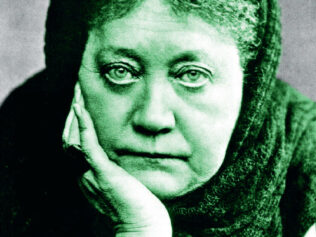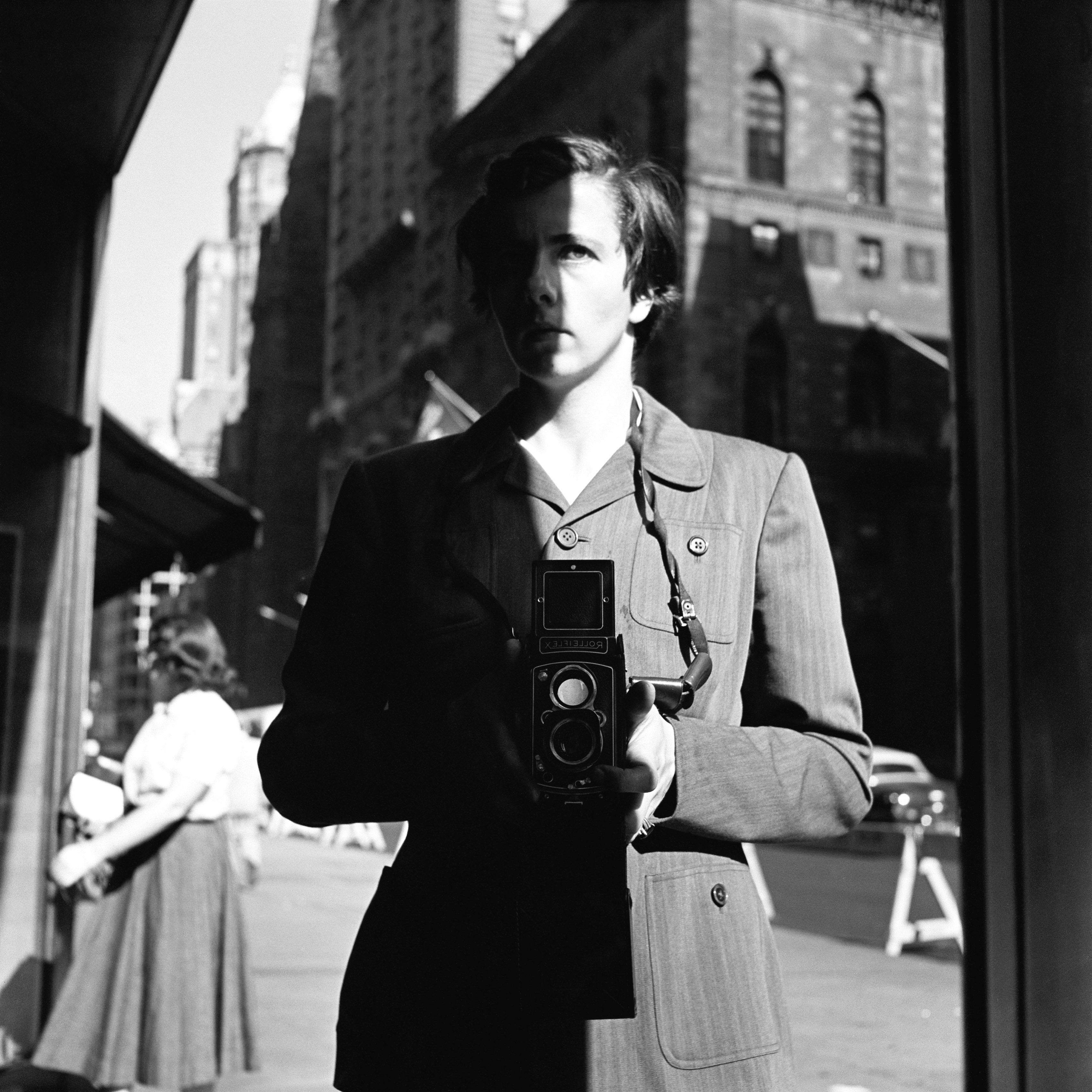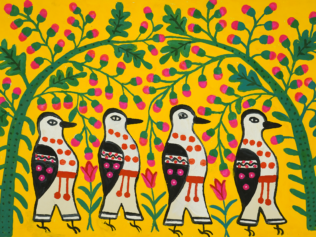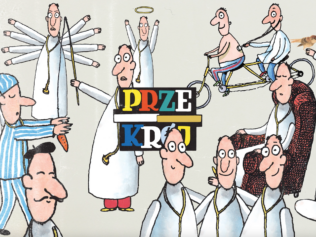
To mark the centenary of Poland regaining its independence, we have been taking a closer look at the odd relationship Poles have with freedom. In this final instalment in the series, I team up with Stanisław Szukalski as he searches for traces of ancient Poles on Easter Island and explores the theory of Zermatism – a concept that would embarrass many of today’s Turbo-Slavs.
USA, April 1940. Stanisław Szukalski sits listening to crackling sounds coming from a radio receiver. An American correspondent is reporting from the Swedish town of Bohuslän on Hitler’s ongoing invasion of Denmark. Szukalski is suddenly struck by the name. Bohuslän, after all, is obviously none other than Bogu slan, the old Polish roots meaning ‘sent to God’. Szukalski spends the following day poring over the oldest available maps of Europe. After many hours, he reaches an extraordinary conclusion: the map of Scandinavia turns out to be filled with names that clearly point to Polish (i.e. Slavic) origins. What’s more, such place-names are to be found all over Europe, as well as on other continents; even, most intriguingly, in the remotest seas. Szukalski will dedicate nearly the next 50 years of his life to solving this puzzle. During this time, he will discover a completely different story of mankind, one in which the Poles played a significant role.
To fulfil the racial purpose
But first, let’s go back in time a bit. As is well-known, the dreams of several generations of Poles finally came to fruition in November 1918, and after spending 123 years under foreign occupation, Poland once again returned to the map of Europe. However, the shape and nature of this new country did not appeal to everyone. Stanisław Szukalski was then one of the most fierce and indiscriminate critics of the Second Polish Republic. Born in 1893 near Sieradz but raised in America, he was one of the most talented sculptors of his generation, having exhibited his works in Chicago and Paris. In the period between the two World Wars, Szukalski visited Poland several times, each time arousing controversy and touching off scandals.
He initially criticized the educational methods used in Polish art schools and called for the closure of the Kraków Academy of Fine Arts. Instead, he proposed establishing a new type of institution to be called the Twórcownia (a neologism meaning ‘Creation-Place’), in which the main criterion for admitting students would be short height and a stocky body type (“any stocky boy with a small face can be an artist”). Together with his students – for whom he invented Old Slavic nicknames: Ziemitrud, Marzyn, Pracowit and Gładziból – Szukalski, now preferring to be known as ‘Stach from Warta’, established the Horned Heart Tribe. Slavic vests designed by Szukalski himself and hairstyles thought to be modelled after the ancient Piast dynasty (i.e. bangs) were a mandatory dress code among this brotherhood.
Szukalski accused Polish artists of worshipping and imitating French art. “We’ve always had art in Poland, but never Polish art,” he claimed. He proposed a return to Slavic and pagan roots, searching for inspiration in Poland’s prehistoric past; in the nearly-forgotten mythical heroes of legends and stories from the ancient era of the Piast dynasty. At the same time, his own sculptures exhibited highly eclectic techniques and themes. In his sculpture of the head of the decapitated hetman Żółkiewski, or his statue of Mussolini as a Roman wolf, we can make out certain exotic traces of Mesoamerican art.
The real problem, however, was that the Poland of his day was ruled by what he saw as has-been elites, often not of Polish origin. The reason for this lay in the most ancient history of Poland. Szukalski’s views on this subject are best depicted in his play entitled Krak, Ludola’s Son. In this version of the legend, the Wawel dragon is a “myth of fear” and “an invention of the oligarchy of elderly priests to control the frightened masses”. In the middle of the night, priests of the god Hjeh-Weh (read: Yahweh) dress up as a dragon made of wood and leather. The group leader is the High Priest Ciuł, who has no arms and is dressed in a black-and-white ceremonial robe reaching all the way to the ground. His task is to “preserve the riches for the Great Nation of Biżymdzi” (read: Żydzi, Jews). He is accompanied by Father Kos, Ciuł’s right-hand man in charge of the public, and the dwarf Zdradar (read: Traitor). This small group wreaks havoc by exploiting and harassing the good-natured Slavic people with stunts like poisoning their wells, etc. Luckily, a civilized Vistulian hero – the titular Krak, the son of Ludola – finally steps in and puts an end to it all. He leads a revolt of the youth, who rise up and suppress the Biżymd (i.e. Jewish) regime. And all this to the tune of a chorus of frogs (the totemic Slavic amphibians) led by the wise frog Rege Rege.
This work, as Szukalski suggests in the preface, was an attempt to devise a new myth that would offer the nation an interpretation of its historical fate. “We are eternal victims of Providence (including that of other nations) pushed around by other peoples’ History; having no Slavic models, what we have is a Semitic Providence. Therefore, we are only her Slaves,” Szukalski explained, his Polish filled with neologisms. The play included a dedication: “To the Slavic Youth, that they may fulfil their racial Purpose”. One can only guess what was meant by this racial purpose.
A statue of the moustached liberator
Interestingly, in imagining his ideal Poland, Szukalski particularly hated the Catholic Church, which he considered to be the second main force behind the enslavement of the true Polish spirit. He believed that baptism and Christianization had erased the true identity of the Slavic people, quoting another famous Turbo-Slav avant la letter, Zorian Dołęga-Chodakowski. It is not surprising that his sculpture of King Bolesław the Brave depicts the ruler trampling on the episcopal mitre of St. Stanislaus.
Szukalski awaited the impending coming of a ‘Second Poland’ – his name for the authoritarian system he so coveted – and in the meantime he busied himself designing its logos and images. The symbol of this country would be the ‘axeagle’, which is a subtle combination of an eagle and an axe. In the latter half of the 1930s, he modified the project slightly, creating an ‘axecross’. This beautiful symbol together with the slogan ‘Let us Forge Economic Unity’ (Polish: ‘Gospodarczą Organizujmy Jedność’, with the abbreviation GOJ) were supposed to be the logo of Christian shops waging a glorious and heroic fight against Jewish commerce. This also shows how, as far the Jews and the Church were concerned, Szukalski considered the latter the lesser of two evils; less harmful to the nation’s well-being.
The spiritual heart of this beautiful land was meant to beat in Kraków, deep inside the Dragon’s Den cave beneath the historic Wawel Castle, the seat of ancient Polish kings. More specifically, in a Slavic cult temple to be built there according to Szukalski’s design, which he called the Duchtynia (another neologism, meaning ‘Spirit-Temple’). In the centre of this temple, next to the graves and monuments of great Poles, there would be a monument to the Liberator (Józef Piłsudski), as well as a statue of the Slavic god Światowid, a symbol of Poland’s return to its Piast-era, pagan roots. This Second Poland, along with other Slavic countries, was to play a key role in a new community of countries in the region, which Szukalski envisioned would be called Neuropa (but would not include England, Germany, France or Italy, imperialist countries known for their love of war). This odd amalgam, bearing some resemblances to other Intermarium concepts, would have as its emblem the gammadion (a reversed swastika). Needless to say, Poland would be the seat of the future world centre of art, the Wiedzucza (a neologism meaning ‘Knowledge-Teaching Place’).
The whole world is my due
Szukalski made no secret of the fact that the only thing that really interested him was Poland: “They consider me a heretic, whereas in fact I’m deeply religious, but this religion is my own, different one. My religion is Polishness.” It is precisely in this broader context of his obsession with Poland, and its legendary but faded ancient history, that the theory of Zermatism developed over the last 50 years of Szukalski’s life. Szukalski wrote about it in a ‘Slavic’ script of his own invention, in 42 richly-illustrated volumes comprising 25,000 pages and 14,000 illustrations, some even drawn using a magnifying glass.
This work, which bears the “timidly-haughty” title, Należy mi się cały świat (known in English as The Whole World Is My Due) is filled with musings on astronomy, geography, geology, anthropology, linguistics and history, all revolving around the main theory that contemporary languages of the world are derived from a protolanguage – which Szukalski called ‘Protong’ (Polish Macimową, a neologism for ‘Mother-Tongue’) – being in fact a version of the Polish language in its original ancient form. So ancient, that it was actually deprived of grammar, and consisted of a small number of simple mini-words or roots (Szukalski distinguished 74 of them). He believed that identifying them and recognizing how they could be ‘re-segmented’ allowed him to reconstruct the true meaning behind most of the world’s historical and geographical names.
And so, Babylon is obviously Baby Lon in Polish, meaning ‘the Old Woman’s Womb’; London is clearly Lon Din, or ‘the Womb of the Day’. Jesus is surely Je Z Us, which means ‘Comes From the Mortally Asleep’, reflecting the fact that he came from Atlantis (as was clearly also the case for Ze-us); Kalahari is of course Ka La Gari, or ‘Land of Flooded Mountains’. Szukalski explained away many other names in the same fashion, from Rome and Gdynia to Zimbabwe and Lake Titicaca.
How could it be possible that all of these names and all the languages of the world are derived from an ancient Polish language? According to Szukalski, it is because after the great flood, which occurred in ancient times, only a handful of ancient Poles who managed to escape from the sunken Easter Island were saved from the cataclysm. Some of them eventually managed to reach dry land, which was the top of the Zermatt mountain in Switzerland (from which the name of the theory also derives). From there, they eventually travelled to the land we know today as Poland.
Szukalski also developed a unique anthropological theory positing that some modern humans are descended from humans and ape-men, conceived as a result of rape. These individuals – characterized by a conical head and lack of neck – called by Szukalski Yetinsynowie (‘Sons of Yeti’), included Russian communists and anarchists (Lenin, Bakunin, Kropotkin), politicians (Machiavelli, Churchill, King Farouk of Egypt), as well as Schopenhauer, Khrushchev and Fidel Castro. They were responsible for all the evil in the world, and above all for all sorts of ‘-isms’, such as fascism and communism.
Self-certain
Of course, all these cockamamie ideas could be easily explained as the products of some form of mental illness. And indeed, before the war Szukalski is said to have exhibited signs of schizophrenia. One doctor who knew Szukalski personally was convinced that the artist represented a clinical case of paranoia, eternally convinced of the worth of his own ideas.
At the same time, his theory clearly has a certain place in Polish culture, which – it has to be said – was certainly not unfamiliar with preposterous theories of this ilk, such as the idea that upper-class Polish nobles were racially superior because they descended from ancient nomadic Sarmatian warriors on horseback (as in the theory of Sarmatian messianism), or the idea that the Polish language had direct links to the language once spoken by Adam and Eve in the garden of paradise (as in the 17th-century musings of Father Dębołęcki). As always, it is difficult to clearly separate this single case from a certain broader psychiatric pattern (which we might diagnose as chronic Proto-Turbo-Slavic Polish nationalism).
And as long as we are speaking of people who might be described as “suffering from an acute case of Poland”, perhaps we should, especially on this centenary of Poland’s independence, mention some other cases of illness caused precisely by such an exclusive, rather than inclusive, conception of the country – be it symbolized by Chrobry’s sword, or by the axeagle. Such patients include the poets Julian Tuwim and Tadeusz Peiper. The former suffered from agoraphobia, as a result of having survived anti-Semitic attacks. The latter developed identity issues (himself coming from a Jewish family), which after World War II eventually turned into persecutory delusions and belief in a German-Jewish conspiracy. All this leads us to pose a certain disturbing question: has Poland been, in addition to everything else, a kind of psychosis-inducing machine?
Translated by Daniel J. Sax










